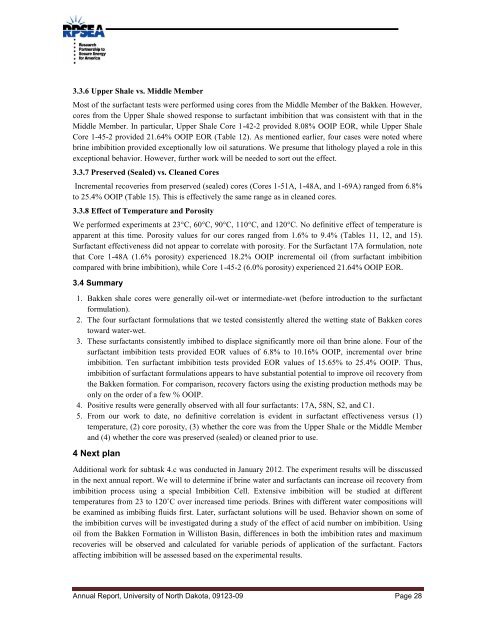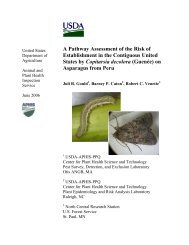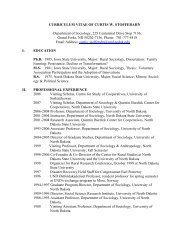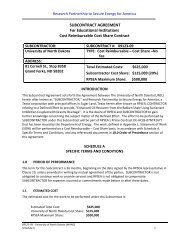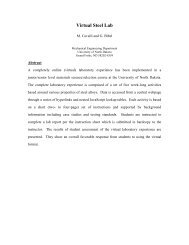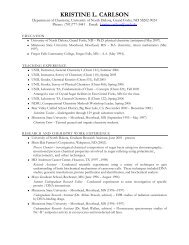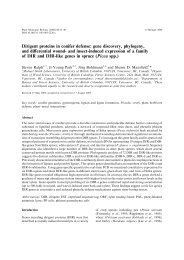Project Management Plan - Small Producers Program - University of ...
Project Management Plan - Small Producers Program - University of ...
Project Management Plan - Small Producers Program - University of ...
Create successful ePaper yourself
Turn your PDF publications into a flip-book with our unique Google optimized e-Paper software.
3.3.6 Upper Shale vs. Middle Member<br />
Most <strong>of</strong> the surfactant tests were performed using cores from the Middle Member <strong>of</strong> the Bakken. However,<br />
cores from the Upper Shale showed response to surfactant imbibition that was consistent with that in the<br />
Middle Member. In particular, Upper Shale Core 1-42-2 provided 8.08% OOIP EOR, while Upper Shale<br />
Core 1-45-2 provided 21.64% OOIP EOR (Table 12). As mentioned earlier, four cases were noted where<br />
brine imbibition provided exceptionally low oil saturations. We presume that lithology played a role in this<br />
exceptional behavior. However, further work will be needed to sort out the effect.<br />
3.3.7 Preserved (Sealed) vs. Cleaned Cores<br />
Incremental recoveries from preserved (sealed) cores (Cores 1-51A, 1-48A, and 1-69A) ranged from 6.8%<br />
to 25.4% OOIP (Table 15). This is effectively the same range as in cleaned cores.<br />
3.3.8 Effect <strong>of</strong> Temperature and Porosity<br />
We performed experiments at 23°C, 60°C, 90°C, 110°C, and 120°C. No definitive effect <strong>of</strong> temperature is<br />
apparent at this time. Porosity values for our cores ranged from 1.6% to 9.4% (Tables 11, 12, and 15).<br />
Surfactant effectiveness did not appear to correlate with porosity. For the Surfactant 17A formulation, note<br />
that Core 1-48A (1.6% porosity) experienced 18.2% OOIP incremental oil (from surfactant imbibition<br />
compared with brine imbibition), while Core 1-45-2 (6.0% porosity) experienced 21.64% OOIP EOR.<br />
3.4 Summary<br />
1. Bakken shale cores were generally oil-wet or intermediate-wet (before introduction to the surfactant<br />
formulation).<br />
2. The four surfactant formulations that we tested consistently altered the wetting state <strong>of</strong> Bakken cores<br />
toward water-wet.<br />
3. These surfactants consistently imbibed to displace significantly more oil than brine alone. Four <strong>of</strong> the<br />
surfactant imbibition tests provided EOR values <strong>of</strong> 6.8% to 10.16% OOIP, incremental over brine<br />
imbibition. Ten surfactant imbibition tests provided EOR values <strong>of</strong> 15.65% to 25.4% OOIP. Thus,<br />
imbibition <strong>of</strong> surfactant formulations appears to have substantial potential to improve oil recovery from<br />
the Bakken formation. For comparison, recovery factors using the existing production methods may be<br />
only on the order <strong>of</strong> a few % OOIP.<br />
4. Positive results were generally observed with all four surfactants: 17A, 58N, S2, and C1.<br />
5. From our work to date, no definitive correlation is evident in surfactant effectiveness versus (1)<br />
temperature, (2) core porosity, (3) whether the core was from the Upper Shale or the Middle Member<br />
and (4) whether the core was preserved (sealed) or cleaned prior to use.<br />
4 Next plan<br />
Additional work for subtask 4.c was conducted in January 2012. The experiment results will be disscussed<br />
in the next annual report. We will to determine if brine water and surfactants can increase oil recovery from<br />
imbibition process using a special Imbibition Cell. Extensive imbibition will be studied at different<br />
temperatures from 23 to 120˚C over increased time periods. Brines with different water compositions will<br />
be examined as imbibing fluids first. Later, surfactant solutions will be used. Behavior shown on some <strong>of</strong><br />
the imbibition curves will be investigated during a study <strong>of</strong> the effect <strong>of</strong> acid number on imbibition. Using<br />
oil from the Bakken Formation in Williston Basin, differences in both the imbibition rates and maximum<br />
recoveries will be observed and calculated for variable periods <strong>of</strong> application <strong>of</strong> the surfactant. Factors<br />
affecting imbibition will be assessed based on the experimental results.<br />
Annual Report, <strong>University</strong> <strong>of</strong> North Dakota, 09123-09 Page 28


